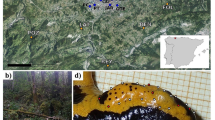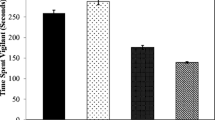Abstract
We investigated the ontogeny of responses to scent marks in immature terrestrial salamanders (Salamandra lanzai) that inhabit the southwest Alps. In this species, sexual maturity is usually reached at about 8 years, and adults exhibit territoriality. One should expect territoriality to take place largely before the acquisition of sexual maturity if sexual competition is not the main force driving territoriality. However, both the difficulties for inexperienced animals to find a suitable territory and size-related competition may delay the acquisition of territoriality in juveniles. We performed choice tests with juveniles belonging to two age groups (1±1 years old versus 4±1 years old). Each focal animal was offered, in random order, the choice between two shelters, one without scent and the other containing one of the following scents: own, same-aged animal, a juvenile belonging to the other age group, or adult female. We also performed choice tests with adult females for which the scents of two juveniles belonging to a different age group were successively offered in a random order. Older juveniles were strongly attracted toward their own shelter and mostly avoided the shelters that contained the scent of juveniles of about the same age and of adult females. Adult females avoided the scents of older juveniles but not younger juveniles. These results therefore suggest that older juveniles use territorial marking. Conversely, young juveniles behaved randomly with respect to their own scents and to those of a same-aged juvenile, and they were significantly attracted towards the odor of an older animal, especially adult females. Both older juveniles and adult females displayed a random behavior toward the scents of young juveniles. Our results suggest that young juveniles do not defend territories but use spaces occupied by older individuals.


Similar content being viewed by others
References
Andreone F (1992) Observations on the territorial and reproductive behavior of Salamandra lanzai and considerations about its protection (Amphibia: Salamandridae). Br Herpetol Soc Bull 39:31–33
Andreone F, Clima V, De Michelis S (1999a) A montane amphibian and its feeding habits: Salamandra lanzai (Caudata, Salamandridae) in the Alps of northwestern Italy. Ital J Zool 66:45–49
Andreone F, Clima V, De Michelis S (1999b) On the ecology of Salamandra lanzai (Nascetti, Andreone, Capula & Bullini, 1988). Number and movement of individuals, and influence of climate on activity in a population of theupper Po Valley (Caudata: Salamandridae). Herpetozoa 12:3–10
Andreone F, Miaud C, Bergò P, Doglio S, Stocco P, Ribéron A, Gautier P (2003) Living at the top: testing the effects of life history traits upon the conservation of Salamandra lanzai. Ital J Zool (in press)
Bel MC, Porteret C, Coulon J (1995) Scent deposition by cheek rubbing in the Alpine marmot (Marmota marmota) in the French Alps. Can J Zool 73:2065–2071
Belden LK, Wildy EL, Hatch AC, Blaustein AR (2000) Juvenile western toads, Bufo boreas, avoid chemical cues of snakes fed juvenile, but not larval, conspecifics. Anim Behav 59:871–875
Brashares JS, Arcese P (1999) Scent marking in a territorial African antelope: I. The maintenance of borders between male oribi. II. The economics of marking with faeces. Anim Behav 57:1–17
Bruce RC, Jaeger RG, Houck LD (2000) The biology of plethodonthid salamders. Kluwer Academic/Plenum, New York
Bull CM, Baghurst BC (1998) Home range overlap of mothers and their offspring in the sleepy lizard, Tiliqua rugosa. Behav Ecol Sociobiol 42:357–362
Carey V, Zager SL, Diggle E (1993) Modelling multivariate binary data with alternating logistic regressions. Biometrika 80:517–526
Duelman WE, Trueb L (1986) Biology of amphibians. McGraw-Hill, New York
Faragher SG, Jaeger RG (1997) Distributions of adult and juvenile red-backed salamanders: testing new hypotheses regarding territoriality. Copeia 1997:410–414
Gasc JP, Gabela A, Cnrobrnja-Isailovic J, Dolmen D, Grossenbacher K, Haffner P, Lescure J, Martens H, Martinez Rica JP, Maurin J, Oliviera ME, Sofianidou TS, Veith M, Zuiderwijk A (1997) Atlas of amphibians and reptiles in Europe. Societas Europaea Herpetologica & Muséum National d’Histoire Naturelle (IEGB/SPN), Paris
Gautier P (2003) De la communication chimique à la territorialité chez les salamandres terrestres d’Europe. Thesis, University of Savoie, Chambéry
Gautier P, Miaud C (1999) Shelter tenacity in terrestrial salamander Salamandra lanzai: experiments on individual recognition by olfaction. In: Miaud C, Guyetant R (eds) Current studies in herpetology. Le Bourget du Lac, France, pp 125–128
Gautier P, Miaud C (2003) Faecal pellets used as an economic territorial marker in two terrestrial Alpine salamanders. Ecoscience 10:134–139
Gosling LM, Roberts SC (2001) Scent-marking by male mammals: cheat-proof signals to competitors and mates. Adv Stud Behav 30:169–217
Graves BM, Duvall D, King MB, Lindstedt SL, Gern WA (1986) Initial den location by neonatal prairie rattlesnakes: functions, causes, and history in chemical ecology. In: Duvall D, Müller-Schwarze D, Silverstein RM (eds) Chemical signals in vertebrates 4. Ecology, evolution and comparative biology. Plenum, New York, pp 285–304
Greven H, Guex G-D (1994) Structural and physiological aspects of viviparity in Salamandra salamandra. Mertensiella 4:139–160
Griffiths RA (1995) The newts and salamanders of Europe. T & AD Poyser, London
Guex G-D, Greven H (1994) Structural and physiological aspects of viviparity in Salamandra atra. Mertensiella 4:161–208
Gunzburger MS, Guyer C (1998) Longevity and abandonment of burrows used by the red hills salamander (Phaeognathus hubrichti). J Herpetol 32:620–623
Jaeger RG (1984) Agonistic behavior of the red-backed salamander. Copeia 1984:309–314
Jaeger RG (1986) Pheromonal markers as territorial advertisement by terrestrial salamanders. In: Duvall D, Müller-Schwarze D, Silverstein RM (eds) Chemical signals in vertebrates 4. Plenum, New York, pp 191–203
Jaeger RG, Forester DC (1993) Social behavior of plethodontid salamanders. Herpetologica 49:163–175
Jaeger RG, Kalvarsky D, Shimizu N (1982) Territorial behaviour of the red-backed salamander: expulsion of intruders. Anim Behav 30:490–496
Jaeger RG, Wicknick JA, Griffis MR, Anthony CD (1995) Socioecology of a terrestrial salamander: juveniles enter adult territories during stressful foraging periods. Ecology 76:533–543
Joly J (1963) La sédentarité et le retour au gite chez la salamandre tachetée, Salamandra salamandra quadri-virgata. C R Acad Sci Paris 256:3510–3512
Joly J (1968) Données écologiques sur la salamandre tachetée Salamandra salamandra (L.). Ann Sci Nat Zool 12:301–366
Kuss O (2002) How to use SAS for logistic regression with correlated data. Proceedings of the 27th annual SAS users group international conference (SUGI 27), pp 261–265
Léna JP, De Fraipont M (1998) Kin recognition in the common lizard. Behav Ecol Sociobiol 42:341–347
Léna JP, Clobert J, De Fraipont M, Ghiot G (1998) The relative influence of density and kinship on dispersal in the common lizard. Behav Ecol 9:500–507
Léna JP, De Fraipont M, Clobert J (2000) Affinity towards maternal odour and offspring dispersal in the common lizard. Ecol Lett 3:300–308
Liang KY, Zeger SL (1986) Longitudinal data analysis using generalized linear models. Biometrika 73:13–22
Main AR, Bull CM (1996) Mother-offspring recognition in two Australian lizards, Tiliqua rugosa and Egernia stokesii. Anim Behav 52:193–200
Mathis A (1990a) Territoriality in a terrestrial salamander: the influence of resource quality and body size. Behaviour 112:162–173
Mathis A (1990b) Territorial salamanders assess sexual and competitive information using chemical signals. Anim Behav 40:953–962
Mathis A, Jaeger RG, Keen WH, Ducey PK, Walls SC, Buchanan BW (1995) Aggression and territoriality by salamanders and a comparison with the territoriality behaviour of frogs. In: Heatwole H, Sullivan BK (eds) Amphibian biology, vol 2. Social behaviour. Surrey, Beatty, and Sons, New South Wales, Autralia, pp 633–676
Miaud C, Andreone F, Ribéron A, De Michelis S, Clima V, Castanet J, Francillon-Vieillot H, Guyétant R (2001) Differences in age, size at maturity and gestation duration among two neighbouring populations of the Alpine salamander Salamandra lanzai. J Zool (Lond) 254:251–260
Nascetti G, Andreone F, Capula M, Bullini L (1988) A new Salamandra species from southwestern Alps (Amphibia, Urodela, Salamandridae). Boll Mus Reg Sci Nat Torino 6:617–638
Noble GK (1939) The role of dominance in the social life of birds. Auk 56:263–273
Powell RA (2000) Animal home ranges and territories and home range estimators. In: Boitani L, Fuller TK (eds) Research techniques in animal ecology. Columbia University Press, pp 65–103
Ribéron A, Miaud C (2000) Home range and shelter use in Salamandra lanzai. Amphibia-Reptilia 21:255–260
Ribéron A, Miaud C, Guyétant R (1996) Taille, sex ratio et structure d’âge d’une population de Salamandra lanzai (Caudata, Salamandridae) dans les Alpes du sud-est de la France. Bull Soc Herpetol Fr 77:35–45
SAS Institute (2001) SAS user’s guide: statistics. SAS Institute, Cary, NC
Sayler A (1966) The reproductive ecology of the red-backed salamander, Plethodon cinereus, in Maryland. Copeia 1966:183–193
Simons RR, Jaeger RG, Felgenhauer BE (1997) Competitor assessment and area defence by territorial salamanders. Copeia 1997:70–76
Stamps JA (1977) Social behaviour and spacing patterns in lizards. In: Gans C, Tinkle DW (eds) Biology of the reptilia: ecology and behaviour. Academic Press, London, pp 265–335
Stamps JA (1988) Conspecific attraction and aggregation in territorial species. Am Nat 131:329–347
Stamps JA (1991) The effect of conspecifics on the habitat selection in territorial species. Behav Ecol Sociobiol 28:29–36
Sun L, Müller-Schwarze D (1998) Anal gland secretion codes for family membership in the beaver. Behav Ecol Sociobiol 44:199–208
Verrell PA (1986) Wrestling in the red-spotted newt (Notophthalmus viridescens): resource value and contestant asymmetry determine contest duration and outcome. Anim Behav 34:398–402
Walls SC (1991) Ontogenic shifts in the recognition of siblings and neighbours by juvenile salamanders. Anim Behav 42:423–434
Wolff JO (1993) What is the role of adults in mammalian juvenile dispersal? Oikos 68:173–176
Acknowledgements
We express our gratitude to the Région Rhône-Alpes, who provided financial support for this study, and to M. Blanchet of the Parc Naturel Régional du Queyras for granting us access to the field station where the Salamandra lanzai were collected. We thank A. Holtham and K. Poppe for correcting the English version of this paper. We wish to thank A. Mathis and two anonymous reviewers for their very useful comments on an earlier draft of this manuscript. The official authorizations to perform this study were obtained from the French Ministry of Environment (license no. 96/180).
Author information
Authors and Affiliations
Corresponding authors
Additional information
Communicated by A. Mathis
Rights and permissions
About this article
Cite this article
Gautier, P., Léna, J.P. & Miaud, C. Responses to conspecific scent marks and the ontogeny of territorial marking in immature terrestrial salamanders. Behav Ecol Sociobiol 55, 447–453 (2004). https://doi.org/10.1007/s00265-003-0732-y
Received:
Accepted:
Published:
Issue Date:
DOI: https://doi.org/10.1007/s00265-003-0732-y




